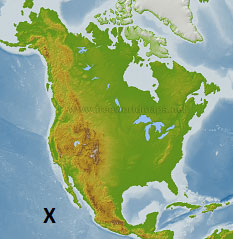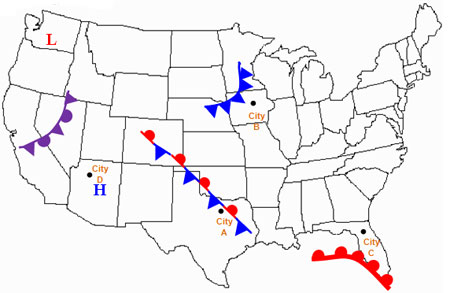
Which of the following statements about pressure systems is/are correct?
A. I only
Incorrect. I is correct but are there other statements that are also correct?
B. I and II only
Correct! III and IV are incorrect. High pressure systems are usually associated with clear skies and calm weather while low pressure systems are usually associated with high winds, warm air, storms and precipitation.
C. I, II and III only
Incorrect. I and II are true statements but look closely at statement III. High pressure systems are usually associated with clear skies and calm weather.
D. I, II, III and IV
Incorrect. I and II are true statements but high pressure systems are usually associated with clear skies and calm weather while low pressure systems are usually associated with high winds, warm air, storms and precipitation.
What are the two characteristics that define an air mass?
A. Temperature and time of year
Incorrect. Temperature is a characteristic that defines an air mass but not time of year.
B. Moisture and the tilt of the earth
Incorrect. Moisture is a characteristic that defines an air mas but not the tilt of the earth.
C. Time of year and tilt of the earth
Incorrect. Neither of these are characteristics that defines an air mass.
D. Temperature and moisture
Correct!
What type of air mass would form over the area marked with an X on the map below?

A. Continental Polar
Incorrect. Continental masses form over land and polar masses form over the polar regions.
B. Maritime Polar
Incorrect. It is a maritime mass because maritime masses form over the oceans but polar masses form over the polar regions.
C. Continental Tropical
Incorrect. It is a tropical mass because tropical masses form over the tropics but continental masses form over land.
D. Maritime Tropical
Correct! Maritime masses form over the water and tropical masses form in the tropics.
A front that forms when a warm air mass is trapped between cold air masses and is forced to rise is a —
A. cold front
Incorrect. A cold weather front is a region where a cold air mass is replacing a warmer air mass.
B. warm front
Incorrect. A warm weather front is a region where a warm air mass is replacing a cold air mass.
C. stationery front
Incorrect. Stationary fronts occur when a warm air mass meets a cold air mass but neither has enough force to move the other.
D. occluded front
Correct!

Which city can expect thunderstorms to form?
A. City A
Incorrect. There is a stationary front over city A. Stationary fronts produce weather similar to warm fronts, so city A can expect drizzly precipitation.
B. City B
Correct! A cold front is moving toward city C. Cold fronts bring thunderstorms followed by cool weather.
C. City C
Incorrect. A warm front is moving toward City C. Warm fronts generally bring precipitation followed by clear warm weather conditions.
D. City D
Incorrect. High pressure systems are associated with clear weather.